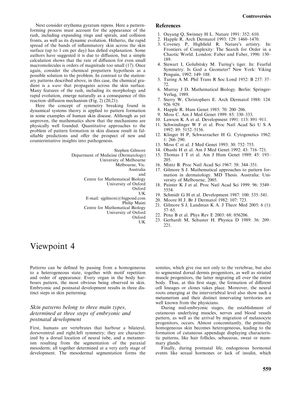TLDR Skin patterns form through molecular signals and genetic factors, affecting healing and dermatology.
The document discussed the formation and patterning of skin during embryonic and postnatal development, emphasizing the role of molecular signals and genetic factors. It highlighted the establishment of skin patterns, including hair follicles and glands, through interactions between the mesoderm, neural crest, and their environment. The study explored mathematical modeling of these patterns, particularly reaction-diffusion systems, and noted the potential for further research to understand the complex mechanisms behind skin patterning and its implications for dermatological conditions. It also examined the influence of geometry and size on pattern formation in animals and the application of these models in wound healing and surgical incision lines, emphasizing the importance of initial conditions and local anatomical factors in predicting healing outcomes.
130 citations
,
February 2005 in “Proceedings of the National Academy of Sciences” Corneal cells can transform into skin and hair cells through specific signals.
112 citations
,
January 2004 in “The International journal of developmental biology” Feather patterns form through genetic and epigenetic controls, with cells self-organizing into periodic patterns.
 759 citations
,
February 2009 in “Current Biology”
759 citations
,
February 2009 in “Current Biology” Hair follicles are complex, dynamic mini-organs that help us understand cell growth, death, migration, and differentiation, as well as tissue regeneration and tumor biology.
 72 citations
,
April 2008 in “Organogenesis”
72 citations
,
April 2008 in “Organogenesis” Wnt signaling is crucial for skin and hair development and its disruption can cause skin tumors.
 207 citations
,
March 2012 in “Development”
207 citations
,
March 2012 in “Development” Skin needs dermal β-catenin activity for hair growth and skin cell multiplication.
 11 citations
,
October 2021 in “Frontiers in Cell and Developmental Biology”
11 citations
,
October 2021 in “Frontiers in Cell and Developmental Biology” Non-coding RNAs are important for hair growth and could lead to new hair loss treatments, but more research is needed.
13 citations
,
April 2023 in “Biochemical Society Transactions” Tissue stiffness helps shape how organisms develop.




